
On my Facebook Page, "Warlords of Cinematic Imagination", I previously wrote a series of four articles on different aspects of "The House of Hammer". For me, my love of their work started when I was an 8-years old boy in 1955. I have brought these articles together unaltered in the following rather long four-part article.
PART ONE: BERNARD QUATERMASS
A Classic character from the history of British Science Fiction.
In 1955 I encountered two interesting things coming out of the U.K. The first was “The House of Hammer” and the second was “Bernard Quatermass”. Although in this case he was played by American Brian Donlevy and referred to as Canadian to cover the lack of a British accent.
The film I saw was “The Creeping Unknown”, which a decade later I would discover was really “The Quatermass X-periment” and originated on the BBC as a television serial. Before that however, I would discover in 1957 “The Enemy from Space” and be surprised to find my old friend Bernard Quatermass once more played by Brian Donlevy.
Moving to my service during Viet Nam in the United States Navy, one afternoon in 1967, on leave from the U.S.S. Shangri-la CVA-38, I would discover another Hammer Film this time in color entitled “Five Million Years to Earth” and be reunited once more with Bernard Quatermass, but played by the distinguished British Actor Andrew Keir. These last two films in their original “House of Hammer” titles where: “Quatermass 2” and “Quatermass and the Pit”.
Back on July 18, 1953 BBC audiences first heard the opening theme: “Mars, Bringer of War” by Gustav Holst composed in 1914 that would be used on all six episodes of “The Quatermass Experiment.” The serial had been written for the BBC by Nigel Kneale. Each of those six episodes also ended with the musical piece “Inhumanity” composed by Trevor Duncan for this specific BBC program. As a side note Duncan’s “Grip of the Law” was used as the opening music for Ed Wood’s “Plan 9 from Outer Space”.
Professor Bernard Quatermass is the head of the “Rocket Group” dedicated to Space Exploration for the United Kingdom. In both the original 1953 television serial where he was played by Reginald Tate and the 1955 movie played by Brian Donlevy. The story opens with him awaiting the return of the first Space Ship ever sent into Outer Space. A typical 1950’s scenario, but this is British television and we have a strong adult content story line. As compared to American Science Fiction television shows which were aimed at children and teenagers. In the U.S. you had programs such as “Tom Corbett, Space Cadet” and “Rocky Jones, Space Ranger” for example as opposed to "The Quatermass Experiment" in the U.K.
The “Quatermass Experiment” was therefore something entirely different than what I and other 1950's American youths saw and was aimed at an intelligent adult audience as many BBC Science Fiction programs would be in the future.


Above Reginald Tate as Quatermass

Above Brian Donlevy as Quatermass

Above Reginald Tate as Quatermass

Above Brian Donlevy as Quatermass
Quatermass' space ship returns crashing into the Earth, but only one crew member Victor Carroon is found inside. However, the spacesuits for the other two crewmen have the appearance of having been worn and from there positions as if those crewman where actually in them. The “Rocket Group” notices that the air lock doors have never been opened which wouldn't make wearing the spacesuits required on the mission, So for the moment a double mystery faces Bernard Quatermass. Why do the suits seemed worn and what happened to the other two members? So starts one of the most gripping Science Fiction adventures from the BBC both on television and as a movie.
The television serial and the movie versions have differences in content reflected by their running times. The original television serial was approximately 3 hours while the movie is a minimal 82 minutes in length.
In the serial Doctor Gordon Briscoe from the “Rocket Group” has been having an affair with Carroon’s wife Judith. There is no affair in the movie. In the television series Carroon is kidnapped by a group of foreign agents who want the information they believe he has learned while traveling in space. In the movie Judith hires a private investigator to break her husband out of guarded room in a hospital.
In the television series there is a Journalist named James Fullalove (Don’t ask about that name) involved with getting the inside story on Carroon and the failed space flight. Because of time restraints that character is not in the movie. Both the serial and the movie have the character of Inspector Lomax of Scotland Yard though.
Both stories parallel each other as Quatermass views in flight footage showing some form of light, radiation (?), entering the Space Ship. All three crewmen are viewed putting on their space suits. Then the footage shows the two other crewman with Carroon seeming to dissolve.
Carroon is transforming into something alien and leaving spores all over London. A race is on to find him and stop what could be the end of the human race.

Carroon is transforming into something alien and leaving spores all over London. A race is on to find him and stop what could be the end of the human race.
The climax of both the television serial and the movie comes in Westminster Abbey where a television crew working on an architectural program locates the creature that Carroon has become on the overhead scaffolding.

Again the final ending changes between the BBC Mini-series and the Hammer Film. In the television series Quatermass convinces the consciousness’ of the three crewmen he believes still are within the alien organism to turn against it. He appeals to their last remaining humanity and this leads to defeating the organism. In the movie version the creature is killed by electrocution from wires hanging around it from the television crew.
The movie version of “The Quatermass Experiment” premiered in the U.K. on August 28, 1955. Two months later on October 22, 1955 Bernard Quatermass, this time played by John Robinson, returned to the BBC’s airways in “Quatermass 2” also written by Nigel Kneale. Once more we are looking at an approximate 3 hour serial versus an 85 minute movie version again starring Brian Donlevy. Of note is that Donlevy’s career was on the skids after being a major actor between the mid-1930’s through the 1940’s and he took the part of Bernard Quatermass solely for money. His performance at times gives you that impression also.
Again the final ending changes between the BBC Mini-series and the Hammer Film. In the television series Quatermass convinces the consciousness’ of the three crewmen he believes still are within the alien organism to turn against it. He appeals to their last remaining humanity and this leads to defeating the organism. In the movie version the creature is killed by electrocution from wires hanging around it from the television crew.
The movie version of “The Quatermass Experiment” premiered in the U.K. on August 28, 1955. Two months later on October 22, 1955 Bernard Quatermass, this time played by John Robinson, returned to the BBC’s airways in “Quatermass 2” also written by Nigel Kneale. Once more we are looking at an approximate 3 hour serial versus an 85 minute movie version again starring Brian Donlevy. Of note is that Donlevy’s career was on the skids after being a major actor between the mid-1930’s through the 1940’s and he took the part of Bernard Quatermass solely for money. His performance at times gives you that impression also.
There are some major differences once more between the television and movie versions.
Both the television serial and the movie are considered weak entries in what is an excellent Science Fiction series, but British Film Critics and some others did comment about the underlining story that is especially strong in Nigel Kneale’s script for the serial. “Quatermass 2” took on the damaging effects of industrialization in Britain and the corruption of governments and big business in an allegorical form using Space Aliens. Note: A similar theme is the basis for the original Japanese script for 1962’s “King Kong vs Godzilla” seven years later.
Both the television serial and the movie are considered weak entries in what is an excellent Science Fiction series, but British Film Critics and some others did comment about the underlining story that is especially strong in Nigel Kneale’s script for the serial. “Quatermass 2” took on the damaging effects of industrialization in Britain and the corruption of governments and big business in an allegorical form using Space Aliens. Note: A similar theme is the basis for the original Japanese script for 1962’s “King Kong vs Godzilla” seven years later.
Another note to my reader was the reason the BBC actually made this program. It really had nothing to do with the success of the first live broadcast, but the fact that the BBC now had competition in the new television network "ITV" and the first British ratings war had begun.
Like its previous serial Hammer's “Quatermass 2” clearly illustrates the restraints from taking a successful television mini-series and attempting to make it into a movie. Even if it’s again in the hands of “The House of Hammer”. To begin with the serial had more characters and a chance to better establish character relationships. In the serial the viewer meets Paula Quatermass the daughter of the Professor. Also we have her finance Army Captain Johnny Dillon making the involvement of Bernard Quatermass more interesting as the Captain comes under the Alien’s control. In the movie both characters do not exist and Dillon is replaced by a colleague of Quatermass named Marsh who becomes the one under Alien control.
Even the arrival of the Alien’s has a major change. In both versions Professor Quatermass and the “Rocket Group” have made plans to build a Moon colony. An environmentally controlled complex of buildings designed to permit human’s to survive and work on the alien surface of the moon. Meteorites start landing in an area of England known as Winnerden Flats.
In the movie version Quatermass and Marsh are just traveling through the area around Winnerden Flats, because of the reports of the meteorites. When they discover a huge complex under construction that is apparently based upon the “Rocket Groups” Moon colony.
In the movie version Quatermass and Marsh are just traveling through the area around Winnerden Flats, because of the reports of the meteorites. When they discover a huge complex under construction that is apparently based upon the “Rocket Groups” Moon colony.
While in the serial we are told that one of the two “Rocket Groups” nuclear powered space ships has exploded in Australia killing hundreds of people. This event has stopped any plans of Quatermass to build his Moon colony. Then Dillon approaches him about the falling meteorites.
In both versions either Dillon, or Marsh pick up one of the meteorites and ammonia gas is sprayed on their faces causing a distinctive mark to appear. In both versions guards from the plant with similar marks on their faces take either man away and the Professor is prevented from following by the local Winnerden Flats Police Force.

Back in London, in both versions, Quatermass attempts to talk to someone in Parliament about the complex and discovers that one of the members has the same mark on his face. In the movie the Professor contacts his old friend from Scotland Yard Lomax who puts him in touch with a Vincent Broadhead who is attempting to uncover the secrecy around this plant that is supposed to be making “food” to ease the food shortages in the World. In the television serial we discover there are similar plants in Brazil and Siberia.
Quatermass tries to investigate further in the serial and discovers other members in high government positions have the mark and when he goes to speak once more with Broadhead he now finds the mark upon him and Broadhead telling him there is nothing to be concerned over. In the movie Quatermass and Broadhead become part of an official tour of the plant and while on the tour Broadhead slips away to look over the plant. Quatermass finds him dying covered with a black slime.

Quatermass returns to Lomax and tells him his theory that the plant is not making food, but providing an environment for alien invaders of some kind. When Lomax goes to his superiors he discovers, or course, that the Commissioner of Police now has the mark.
While in the serial Paula and Dr. Leo Pugh the Mathematical Genius of the “Rocket Group” have discovered an asteroid is orbiting the Earth. It is releasing the meteorites when it gets to a near point of 400,000 miles over the Earth every 14 hours. In this version it is a Civil Servant named Ward that gets covered by the black slime after attempting to enter restricted areas of the complex. Quatermass discovers that Dillon had been taken to the complex’s infirmary, but has been released and his whereabouts are unknown.
It is at this point in both versions of the story that the ability to do a mini-series over an 85 minute film even of the quality of “The House of Hammer” comes into play. We are at the climax where Professor Bernard Quatermass must defeat the aliens.
In the movie Quatermass realizes that the Earth’s atmosphere must be poisonous to the creatures. So he sabotages the life support system in the domes of the complex that house the alien life forms. With their Life Support gone the individual creatures unite to form 150 foot monsters that burst from the domes. At the same time one of the “Rocket Groups” other members sacrifices his life to launch the “Quatermass 2” rocket ship at an asteroid. The Professor believes it is the base of operations for the invasion of Earth and is hiding within the Earth’s own shadow. As a result of the nuclear explosion the giant space creatures die and the marks are removed from the humans working for them. They have no memory of being under the control of the aliens, but otherwise their memories are untouched.
In the movie the “Quatermass 2” is the second deep space rocket the Professor promised he would build at the end of the movie version of “The Quatermass Experiment”. In the television series the story line is slightly different, but the second ship’s name is the real reason for the original British title which of course also is a play on the fact that this is the “Second” Professor Bernard Quatermass program by the BBC.
In the serial’s ending Quatermass returns to his recreated Moon Colony and disguised as a guard leans that the creatures are from a Moon of Saturn and that they needed his project design to survive on earth. He watches the smaller creatures from the meteorite form into the first of the giant ammonid alien creatures. The use of the name “ammonid” by Nigel Kneale shows the thinking that went into the BBC story to create a believable opponent for the Professor. Ammonia aka: azane is a compound of nitrogen and hydrogen. In Kneale’s thinking he knew that ammonia is involved with the nutritional needs of terrestrial organisms by serving as precursor for food. So way not an alien life form the “ammonid” who feeds off of an ammonia compound?
Construction workers not in the control of the aliens overhear a conversation between Quatermass and a newspaper man. They decide to take over the plant and riot. In the battle between the controlled guards and the workers. One of the workers gets hold of a bazooka fires it at the dome containing the ammonid’s. The result is the entire plant complex is destroyed and ammonia gas is dispersed into the countryside. Wearing a gas mask Professor Quatermass escapes.
Returning to the “Rocket Group” Quatermass finds the still controlled Captain Dillon and a group of British Paratroopers have taken control of the firing base where the second rocket has been brought from Australia. The Professor finds out that Dillon has instructions from the “very top” of the British Government to prevent him from launching his space craft at the asteroid. However, Dr. Plugh is able to convince Dillon to let the rocket launch.
Quatermass and Dr. Plugh take the “Quatermass 2” and land on the asteroid where Plugh attempts to kill the Professor. Who was aware that Dr. Plugh was possessed by the ammonids. When Plugh attempts to shoot Quatermass with a gun the recoil sends him floating off into space.
Quatermass jettisons the nuclear motor of the space craft and flies into space using the conventional power supply. The nuclear motor explodes destroying the asteroid and the ammonids and freeing all the people under their control.
As I said a major difference in story lines. The movie version even though critics panned it did very strong box office, but it was overshadowed by another British film of the same year teaming up Peter Cushing and Christopher Lee for the first time: “The Curse of Frankenstein” the first color Frankenstein picture. Additionally writer Nigel Kneale co-wrote the screenplay, he did not write the one for the first movie based upon his television script, accused Brian Donlevy of being drunk on the set daily. According to Val Guest who directed both movies this was untrue.
There have been many stories and films about Martian Invasions of Earth going back to H.G. Wells’ “The War of the Worlds”. Ray Bradbury’s classic 1950 work “The Martian Chronicles,” which is actually a collection of 1940’s short stories he wrote for different magazines that includes one in which a person believes he might be one of the dead Martian’s. Eight years after Bradbury’s short story collection was released in 1958 Nigel Kneale wrote “Quatermass and the Pit” for BBC television and there was no doubt the "We were the Martians". The motion picture version also written by Kneale would not be made until 1967 nine years after it appears on the BBC.
This specific serial is considered an influence on both Stephen King and John Carpenter. It was considered in 2000 to be one of the 100 greatest British television programs. Playing Professor Bernard Ouatermass was Andre Morell (Dr. Watson to Peter Cushing’s Sherlock Holmes in Hammer’s 1959’s “The Hound of the Baskervilles”. The same year he co-starred in “Behemoth: The Sea Serpent”, he also appeared both in Hammer’s “She” and “The Vengeance of She” and voiced Elrond, Celeborn in Ralph Bakshi’s 1976 “The Lord of the Rings”).
The serial starts with Bernard Quatermass being forced out of “The Rocket Group” which has now been taken over by the British Government. A pre-human skull is discovered at a construction site on Hobbs Lane which previously was spelled Hob’s Lane. The word “Hob” is an antiquated name for the Devil and is located in Knightbridge. An exclusive residential district of London.
Paleontologist Matthew Roney was called to the site and reconstructed from one skull a dwarf like humanoid. This humanoid seems to have an unusually large brain volume for a pre-human from thousands of years ago. However, before Roney can continue his work the Military are called in when what is believed to be some type of Nazi World War 2 bomb has been discovered. This “bomb” is in “the Pit” created by the excavation. Roney believes the excavation has uncovered a major archaeological find, but the military orders him to shut down his dig.


BBC serial space craft Motion picture version
BBC serial space craft Motion picture version
Roney contacts his friend Professor Bernard Quatermass to help him get around the military. Quatermass and Colonel Breen the new head of the “Rocket Group” become interested with the site, but for different reasons. As the “Nazi bomb” is further uncovered from the surrounding dirt additional skulls are discovered. Roney dates them as being five million years old. To complicate matters the skulls were found not around the object, but “in it” making this so-called bomb also five million years old. Colonel Breen considers that ridiculous. As the interior of “the bomb” is further cleaned on one wall is discovered a pentagram. Roney believes there is a chamber of some kind located behind it.
Meanwhile a contractor arrives and sets up a borazon drill, made from a substance harder than a diamond, for cutting to get samples of the hull of “the bomb” for testing. The shell casing resists the drill and not even a scratch is made, but the drill’s vibrations cause distress to those around the object as if from an ultrahigh pitched sound in their heads.
Quatermass leaves the excavation to interview the local residents and discovers that “ghosts” and other forms of “poltergeist” activity have been recorded going back centuries around Hobbs Lane. He also finds out that Hobbs Lane was originally spelled Hob’s Lane. As the Professor returns to the dig a soldier is brought out in hysterics. He claims to have seen a dwarf like person walk through the wall of the five million year old “bomb” which fits a description in a 1927 newspaper account pertaining to “ghosts” seen on “Hobs Lane”.
It is then noticed that a hole, where there was none before, has appeared in the inside wall with the Pentagram on it. Within it are found the remains of insect like creatures resembling three legged locusts with stubby antennae on their head which give the impression of horns. In short reminding people of the devil. Professor Quatermass and Roney start examining the aliens and deduce they came from a planet that five millions years ago could have sustained life, Mars.
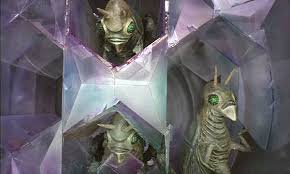

After everyone else leaves the area, but the military guards. While putting his tools away the drill operator accidentally triggers more psychic energy from the now identified space craft. Something frightens him and he leaves the pit area running through the streets and seeks safety in a church where Quatermass and Roney find him. He tells the two that he had visions of the aliens killing each other in mass. The Professor comes to the conclusion that some psychic memory is stored in the space craft and it passes to people who come in contact with it.
After everyone else leaves the area, but the military guards. While putting his tools away the drill operator accidentally triggers more psychic energy from the now identified space craft. Something frightens him and he leaves the pit area running through the streets and seeks safety in a church where Quatermass and Roney find him. He tells the two that he had visions of the aliens killing each other in mass. The Professor comes to the conclusion that some psychic memory is stored in the space craft and it passes to people who come in contact with it.
Professor Quatermass then uses an invention of Roney’s called an “optic-encephalogram” which can record impressions from the optic center of the brain. They bring the device to the Pitt and the Professor places it on his head. However, it is Roney’s assistance Barbara Judd who actually starts to see visions and the device is moved to her head. What she witnesses is a bloody Martian purge of the locust like Martian’s hive to get rid of unwanted mutations.
Quatermass comes up with a theory that in Earth’s distant past the Martian’s took apes and pre-humans back to Mars. They were genetically altered to have special abilities such as telepathy, telekinesis and other psychic powers. Then those who had been altered were returned to carry on the dying Martian line, but in bodies adopted for the planet Earth. The space craft must have crashed and that was why it was still here.
Quatermass thinks this explains people with telepathic powers and also witchcraft were the Pentagram is often used. To him it wasn't the sign of the Devil as the Religious Witch Finder Generals thought, but a sign of the Home World Mars.
Colonel Breen and others don’t buy this story even after viewing the pictures of the Martian purge Barbara saw. They are still convinced that this is some propaganda weapon sent to London by the Nazi’s and it is doing exactly what they had planned only at the wrong time. Breen holds a media event to alleviate people’s fears, but Professor Quatermass is concerned that what he refers to as a “racial memory” of Mars may still be ingrained in some people within an alien gene and if set off there would be an ethnic cleansing of those the Martians view as impure and weak. Breen will not hear such nonsense.
The media event takes places and the alien craft seems to come alive. Breen cannot take his eyes off of the Martian Space Craft and eventually dies from the energy radiating out of it. What Quatermass fears comes true and people start rioting and through psychic power killing others in the streets of London. The space craft seems to melt away and a large holographic image of one of the aliens truly resembling the Devil floats in the skies above London.
The image seems to be feeding off the psychic energy of London’s population and growing. Professor Quatermass has come under the power of the alien purge and attempts to kill Roney who does not possess the alien gene, but Roney manages to shake Quatermass out of his trance. At this point Roney remembers old legends of demons and their fear of water and lead and believes a sufficient amount of iron connected to wet earth may short circuit the alien apparition.
With the aid of a soldier, Captain Potter, Quatermass obtains a large lead chain and attempts to hurl it at the apparition, but comes once more under its power. It is up to Roney to walk into the alien form and both are reduced to ashes.
Quatermass later on a television broadcast warns that now that we are aware of the source of our dark urges. We need to be careful about wars, witch-hunts and other forms of communal violence “lest we Martians turn the Earth into a second dead planet”.
The movie version of “Quatermass and the Pit” had an outstanding cast. Playing the Professor was Andrew Keir (1958’s story of the Titanic “A Night to Remember”, the Elizabeth Taylor/Richard Burton “Cleopatra” and from Hammer: “Dracula, Prince of Darkness” and “Blood from the Mummy’s Tomb”), playing Roney was James Donald (“The Bridge on the River Kwaii”, “The Great Escape” and the Kirk Douglas/Tony Curtis picture “The Vikings”) and playing Roney’s assistant Barbara Judd another Hammer alumnus Barbara Shelley (“The Gorgon”, “Dracula, Prince of Darkness”, “Rasputin, the Mad Monk” and “Blood of the Vampire”).
Written once more by Nigel Kneale he tightens up his approximate 3 hour and 30 minute television series into a fast moving and engrossing 97 minutes that was the first Quatermass movie in color. The basic story remained with some slight changes including the ending.
Instead of Roney and Quatermass being friends. They first meet at the excavation when Colonel Breen asks the Professor to accompany him. Also at the dig is Roney’s assistance Barbara Judd who is involved from the start and assists Quatermass in finding out the background for Hobbs Lane. Instead of Roney not having the alien gene he has a metal plate in his head from an earlier surgery that makes him immune to the Martians. Also instead of Roney speculating how the giant alien can be destroyed. It is Quatermass in the film. The lead chain is replaced by a crane being used at the construction site. Roney climbs to the top of it and starts it turning into the alien projection and dies as it bursts into flames and discharges the built up energy to the ground. Also there is no warning message given by the Professor at the film’s conclusion.
On October 24, 1979 the fourth and final Quatermass serial premiered. Not on the BBC but ITV, because of increasing costs the BBC had dropped the project. The title of this approximate 3 hour and 20 minute 4 part series was: “Quatermas” aka: “The Quatermass Conclusion” aka: “Quatermas IV”. Playing Professor Bernard Quatermass was British Actor and film family scion Sir John Mills (Disney’s “Swiss Family Robinson”, “Zulu Dawn”, “Gandhi”, 1956’s “War and Peace” and a distinguished film career from 1932 through 2003).
“In the last quarter of the 20th century, the whole world seemed to sicken. Civilized institutions, whether old or new, fell…as if some primal disorder was reasserting itself. And men asked themselves, ‘Why should this be?”---the opening lines to the serial written once more by Nigel Kneale.
The first part had a retired Professor Bernard Quatermass traveling from Scotland to London looking for his Granddaughter Hettie who has gone missing. The streets are full of gangs and law and order seems to have broken down. He appears on a television show covering a joint United States/ Russian space mission. As the two space ships near each other some unknown force destroys them both. Quatermass meets Astronomer Joe Kapp whose assistants inform the two men that at the exact moment in time that the two space craft were destroyed. Kapp’s radio telescope detected a strong signal coming from space.
Quatermass notices a group of young people acting similar to 1960’s hippies calling themselves the “Planet People”. He fears his granddaughter may have joined them. With the assistance of Kapp the two men follow a group of these “Planet People” to a stone circle of Megaliths and watch in horror as they enter them and are bathed in a bright light leaving only ashes.
In the second part the two men find a girl survivor named Isabel and help her to Kapp’s house where she talks about “lovely lightening”. Making contact with a NASA Scientist named Marshall the two men learn this is happening with young people around the world and they decide to take Isabel to London for tests with the help of a District Commissioner Annie Morgan. Before they get to the Lab to conduct the tests a gang of young people attack the car. Quatermass is taken from the car, but Annie and Isabel manage to escape. The planet people gather close to Kapp’s Radio Telescope at another stone circle near it. Kapp becomes horrified when another bright light shines on his home and finds his family dead.
The third part of the serial shows Quatermass being saved from the youth gang by a group of elderly people who have been forced by the city’s crime to live in a scrap yard. Meanwhile Annie has managed to get Isabel to a hospital where the doctor’s examining her are shocked as she levitates off her hospital bed and explodes into the same type of ashes the other young people had previously turned into.
Kapp is observed sitting and starring at the walls of his home still in shock. While outside the “Planet People” are being joined not only by the street gangs, but the soldiers who were supposed to keep them away from the Megalithic sites. Professor Quatermass, Marshall and a Russian Scientist named Gurov discuss his view that this all has happened before. That these Megalithic sites contain beacons left by some Alien People during Earth’s Prehistoric times to be used when they plan to return which he believes may be happening at that very moment in time.
Jointly the American’s and the Russian’s are sending a space craft under Marshall’s command to make contact with the force in an attempt to reason with it. Professor Quatermass now believes the force is not some alien intelligence, but simply a machine sent out to gather human protein for an unseen alien population. “The Unit” American/Russian craft is destroyed by a beam of light Marshall stated stretches in all directions and seems infinite. While the “Planet People” now numbering in the thousands and still growing are headed for Wembley Stadium. Annie and the Professor drive a car to the Stadium in a fruitless hope of stopping the “Planet People” from continuing to gather there. The mob attacks their car and Annie enters the underground parking area and crashes the vehicle. She is killed at the same time as another alien lightning strike hits Wembley Stadium.
The final part of the serial shows Professor Bernard Quatermass emerging from the car and walking in a street and air full of ashes and no human movement. The Russian Gurov finds Quatermass and they devise a plan to destroy the alien machine. They will detonate a nuclear bomb that they hope will damage the alien machine enough to make it leave Earth. As they prepare the device a large group of the “Planet People” arrive to stop them including the Professor’s Granddaughter Hettie. The two are reunited, but Ouatermass suffers a heart attack. However, Hettie along with Kapp help Gurov and her Grandfather detonate the nuclear bomb.
Latter according to Gurov the apparent sole survivor of the group:
“The message was taken. It has not come again. We pray it will never come again”.
Compared to the previous three programs “The Quatermass Conclusion” was very depressing and also centered on the generation gap that existed in England at the time. It is the older people who appear unaffected by the alien force, because of their stability. John Carpenter stated at the time: “Nigel was very embittered about the way of the world, as was shown, I think in The Quatermass Conclussion.” Verity Lambert, the executive producer, whose first job was to create a little thing in 1963 called “Dr. Who”, said of the serial that it: “didn’t have the staying power of the originals, but then that’s almost inevitable when you try to bring something back in a slightly different form.”
So speaking of both bringing Quatermass back and “Dr. Who.” I move to April 2, 2005 and a live BBC Four broadcast of an updated “The Quatermass Experiment” with a running time of 97 minutes. Professor Bernard Quatermass was played by Jason Flemying (Dr. Jekyll and Mr Hyde in 2003’s “The League of Extraordinary Gentlemen” and John Netley in 2001’s “From Hell), but playing the part of Doctor Gordon Briscoe was David Tennant. It was during the pre-production that Tennant was offered the role of the Tenth Doctor Who. Everyone was well aware of this by the time the show went live and Flemying changed a line in the broadcast he says to David Tennant from:
“Good to have you back Gordon” to “Good to have you back DOCTOR” as a deliberate reference to “Dr. Who”. It would be another couple of weeks before the average British viewer knew David Tennant had accepted the part.


Below David Tennant as the 10th "Dr. Who"
On October 5, 1988 the 25th Season of “Dr. Who” premiered with the story “Remembrance of the Daleks”. The Seventh Doctor played by Sylvestor McCoy and his companion Ace are sent back in time 25 years to “76 Totter’s Lane” the very spot the first episode of the series “An Unearthly Child” took place.
During the serial the 7th Doctor meets Group Captain Gilmore and his Assistant Professor Rachel Jensen. Professor Jensen happens to work for “The Rocket Group” headed by Professor Bernard Quatermass. On April 11, 2009 in “The Planet of the Dead” starring David Tennant as the 10th Doctor. Unit scientific adviser Professor Malcolm Taylor names a unit of measurement after Bernard Quatermass. I’m not through yet.
One again with Tennant as the Doctor on May 5, 2007 was a story entitled “The Lazarus Experiment”. Sound familiar in a way? The ending of this episode all but recreates the ending of the original “Quatermass Experiment”.
Last note to close this article: Writer and creator of the character of Professor Bernard Quatermass Nigel Kneale hated “Dr. Who”.
PART TWO: TERENCE FISHER, WHO I FIRST MET, INDIRECTLY, ON A HOUSE ROOF TOP IN 1957
PART TWO: TERENCE FISHER, WHO I FIRST MET, INDIRECTLY, ON A HOUSE ROOF TOP IN 1957
Its funny how you can sometimes remember things clearly from decades ago and something that happened last month, or even last week is a blur. In this case the first house my parents bought was located in Van Nuys, California and the address was 15144 Martha Street and the phone number was State 6-9075. I was seven when we moved there in 1954.
What makes this address so memorable to me is not playing “Davy Crockett King of the Wild Frontier” with my neighbors, or my crush on Mouseketeer Annette Funicello. It was being scared out of my mind on the roof on that house, sitting with some of my friends, watching the screen of the local Sepulveda Drive-in Theater two blocks away. Of course we couldn't hear a word being said, but I will never forget seeing Christopher Lee remove those bandages covering his face in “The Curse of Frankenstein”. I had weeks of nightmares as a result of the silent moment and a couple of days later I would go to the Van Nuys Theater to see the movie with sound and another Hammer film entitled “X-the Unknown”.
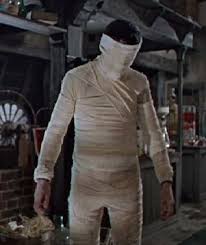

It’s doubtful I will ever see the movie “Tudor Rose” aka in the U.S. as “Nine Days a Queen” made in 1936 starring the future Sir Cedric Hardwicke as the Earl of Warwick and Nova Pilbeam as Lady Jane Grey. As for Nova Pilbeam she is known to true fans of Alfred Hitchcock as Betty Lawrence in his 1934 original “The Man Who Knew Too Much”. However, back to “Tudor Rose” and within the credits it is noted that the film was edited by a T.R. Fisher. Terence Fisher’s first on screen credit for a film. “Tudor Rose” would be followed by eight more editing jobs before the 1948 film “A Song for Tomorrow” DIRECTED by Terence Fisher.
“Prime Wire Movies” describes “A Song for Tomorrow” as:
“Derek Wardwell (Shaun Noble) is struck with amnesia, and the last thing he remembers is the beautiful voice of opera singer Helen Maxwell (Evelyn Maccabe). When he regains consciousness, Wardwell thinks he's in love with her. After his amnesia is cured, Wardwell returns to his fiancee while Helen begins a romance with his doctor.”
A big difference between this film and Fischer's first Science Fiction film for Hammer Film Productions the 1953 “Four Sided Triangle”. The movie dealt with moral and scientific themes that would start the House of Hammer on the road to become the leader of “Intelligent” British Science Fiction and Horror. It would be another two years before the studio would adopt the BBC television series “The Quatermass Experiment” into the outstanding Val Guest directed motion picture and truly set its future position in the 1950’s.

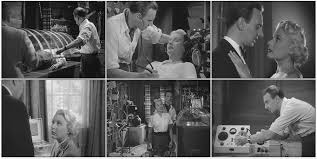
“The Four Sided Triangle” opens with Dr. Harvey the local doctor telling a story to an audience. He relates how Bill and Robin were boyhood friends in love with the same girl Lena. The two scientists create a machine they call “The Reproducer” which can duplicate anything to the last detail. Bill realizes Lena is hopelessly in love with Robin and comes up with the idea of using their invention to make a duplicate Lena. The girl agrees to enter the machine and “Helen” is born. The problem arrives when Helen is TOO perfect a duplicate of Lena and falls in love with Robin also.
Bill believes if he can erase Helen’s memory he has a chance for her to fall in love with him. He uses electro-shock which seems to work, but something goes wrong as the equipment explodes causing a major fire trapping Lena, who was helping Bill with the procedure along with Helen. Dr. Harvey and Robin arrive and are able to save only one women, but is it Lena or Helen. The girl has no memory. However, Dr. Harvey remembers that Bill had to start Helen’s heart and the machine he used left two small marks on the back of her neck. There are no marks so this must be Lena.
Skipping ahead to 1967 Terence Fisher would direct “Frankenstein Created Women” in which the soul of a dead man is placed into the body of his girlfriend Christina. Whose entire left side is partly paralyzed and the left side of her face disfigured. As a result a group of young noblemen tease her constantly. The new Christina is beautiful and the soul of her dead boyfriend uses this to lure those who treated both of them badly to their death. The same moral and scientific themes from “Four Sided Triangle” are repeated in this film and both are usually compared together when discussing the career of Fisher.

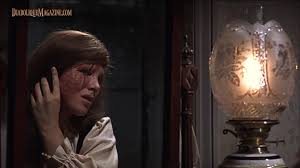

Returning to 1953 Terence Fisher’s followed “Four Sided Triangle” with “Spaceways” a British-American co-production starring Howard Duff and Eva Bartok. Éva Ivanova Márta Szőke was born in Budapest Hungary. Between 1955 and 1956 she was married to German Actor Curd “Curt” Jurgens. Shortly after their divorce her daughter Deana was born. Three decades later Bartok would claim Deana was not Jurgen’s daughter, but Frank Sinatra’s whom she had a short affair prior to the divorce with Curt.

“Spaceways” was a routine Sci-Fi about the first space flight. It even used footage from Robert L. Lippert’s, he was the unaccredited co-producer, film “Rocketship X-M”. Between the rest of 1953 and the end of 1956 Terence Fisher directed crime dramas and a couple of comedy’s all forgotten now, because of what his first film in 1957 would do for both Horror films and “The House of Hammer”.
So there I was sitting on the roof of my house covering my eyes as Christopher Lee pulled those bandages off his face. One day while having a conversation with a friend of mine born in Scotland Fisher's motion picture “The Curse of Frankenstein” somehow came up. When the film opened in the United States I was still 10 years old and able to see it edited as Hammer had made the motion picture. When the film opened in Scotland my friend was 15 years old and unable to see it. Tom and his friends had to sneak into the theater, because in the UK the film censors had issued an “X-Certificate” making the film suitable for those 16 and over only. In 1970 the “X-Certificate” age would be raised to 18 and over and in November 1982 the name changed to the “18 Certificate”. In 1967 while in the Navy I was on the Island of Malta and playing at a local theater was Ray Harryhausen’s “One Million Years B.C.”. The film was restricted to those 21 years and over under “Malta’s X-Certificate”. Again in this country there were no restrictions.

When Universal Studio’s first heard of the project by Hammer. The had their legal team block any attempt by that studio to copy Jack Pierce’s make-up. So Phil Leakey came up with Christopher Lee’s stitched together face which I think works better in color. This of course was the first “Frankenstein” film in the process. Although the original 1931 movie had been planned to be shot in three strip Technicolor, but because of the cost and how Pierce’s make-up looked that idea was dropped. There are color outtakes and Karloff has home video of him in the color make up still in existence.
.
When Universal Studio’s first heard of the project by Hammer. The had their legal team block any attempt by that studio to copy Jack Pierce’s make-up. So Phil Leakey came up with Christopher Lee’s stitched together face which I think works better in color. This of course was the first “Frankenstein” film in the process. Although the original 1931 movie had been planned to be shot in three strip Technicolor, but because of the cost and how Pierce’s make-up looked that idea was dropped. There are color outtakes and Karloff has home video of him in the color make up still in existence.
.
Jimmy Sangster’s script for "Curse of Frankenstein" is very effective. I liked how we first meet the Baron as a young boy and are given a passage of time as he works with Paul allowing his ideas to formulate. The scene bringing the dead puppy back to life also works. I need not dwell on the story as I am sure everyone has seen the film at least once, if not like myself has a copy of it.
The film of course accomplished three things for “The House of Hammer”:
1. Created the team of Peter Cushing and Christopher Lee.
2. Established the studio permanently as the leader in Horror films for the 1950’s and 1960’s World Wide.
3. Along with suddenly pushing the names of Terence Fisher and Jimmy Sangster to the forefront.
1. Created the team of Peter Cushing and Christopher Lee.
2. Established the studio permanently as the leader in Horror films for the 1950’s and 1960’s World Wide.
3. Along with suddenly pushing the names of Terence Fisher and Jimmy Sangster to the forefront.
Although what the British critics said about “The Curse of Frankenstein” though is very interesting.
Dilys Powell of The Sunday Times wrote that such productions left her unable to "defend the cinema against the charge that it debases", while the Tribune opined that the film was "Depressing and degrading for anyone who loves the cinema".
The budget for the film in U.S. dollars was $270,000 and the critics might not have liked the film, but the Box Office reached $8 million dollars. Terence Fisher would make a crime drama starring American actor Pat O’Brien and future Miss Moneypenny Lois Maxwell “Kill Me Tomorrow” to finish 1957 and then enter his real Horror film directing career in 1958 with two films.
I am going to discuss the second of Fisher’s two films first with the tag line: “We Dare You To See It! We Double-Dare You To Forget It!” To me “The Revenge of Frankenstein” is in my humble opinion the most influential horror film “The House of Hammer” ever made.

The film is one of the least remembered especially outside of the UK and was overshadowed by the first Hammer Studios film RELEASED in 1958. In this production Peter Cushing returned as Dr. Frankenstein and Jimmy Sangster’s script did two things that in my view make the film so influential. The first happens at the start of the movie in what is simply a prologue and the second occurs at the very end which would set the future for Cushing and fans of Mary Shelley’s creation.
The film opens with the ending of “The Curse of Frankenstein” as Victor is led to the guillotine by the priest, but adds that the priest not Frankenstein was the one beheaded. This switch leaves Victor to become the successful “Dr. Stein” in the town of Carlsbruck. Where he refuses to join the local Doctor’s Association and is taking away their business including their wives. The film ends with Cushing being attacked by the patients of his hospital that he has being using for spare parts by pretty much killing him. His assistant Dr, Hans Kleve transfers Dr. Stein’s brain into a new body and we next see Peter Cushing as “Dr. Franck”. Naturally.
The film opens with the ending of “The Curse of Frankenstein” as Victor is led to the guillotine by the priest, but adds that the priest not Frankenstein was the one beheaded. This switch leaves Victor to become the successful “Dr. Stein” in the town of Carlsbruck. Where he refuses to join the local Doctor’s Association and is taking away their business including their wives. The film ends with Cushing being attacked by the patients of his hospital that he has being using for spare parts by pretty much killing him. His assistant Dr, Hans Kleve transfers Dr. Stein’s brain into a new body and we next see Peter Cushing as “Dr. Franck”. Naturally.
Jimmy Sangster and Hammer have substituted the Universal Studios idea of the undying monster with the undying Doctor. Three novelizations of the script were made. The first published by Panther Books in 1958 written by Sangster using the pen name Hurford Janes, the second by John Burke in 1966 and the third by Shaun Hutson in 2013.
I said that this film was overshadowed by the first film released in 1958 by Hammer Studios. Actually Terence Fisher and Peter Cushing were doing double duty as both “The Revenge of Frankenstein” and “Dracula” aka: “The Horror of Dracula”, a title change to avoid confusion over the Tod Browning/Bela Lugosi version in the United States, were being filmed simultaneously using the same sets. Two examples: Frankenstein’s surgery was also Dracula’s crypt and the Baron’s laboratory exterior was also Castle Dracula’s exterior.
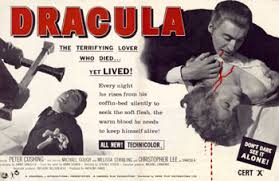

Hammer’s “Dracula” completely reworked the Bram Stoker story and brought back the team of Peter Cushing as Dr. Abraham Van Helsing and Christopher Lee as Count Dracula. Lee was not the first choice for the count, because he was considered too small in physical stature. Excuse me?
Some interesting points about the film.
Lee would be forever associated with Dracula and make six more Dracula films for Hammer. Except for the paycheck he hated every other film than the original, because basically he never spoke a line again and the character of Dracula just became the catalyst which the story was built around and not really the centerpiece. In 1970 Christopher Lee would star in a Spanish film “Conde Dracula” directed by Jesus Franco, with Herbert Lom as Van Helsing and Klaus Kinski as Renfield. Although the film didn’t do well. Lee enjoyed making this film. The critics panned it, because it was boring and kept following the original book to much for them. It was probably the first ever film to actually present the Count as Bram Stoker described him starting out an old man and getting younger. There is a great monologue that Lee delivers with Stoker’s own words. The only problem to the viewer is London looked like Victorian Era Madrid and the clothing fits Spain not England. I have the DVD of the film.
Below Christopher Lee in Hammer's "Dracula"
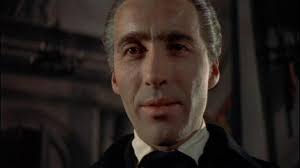
Below Christopher Lee in Jesus Franco's "Conde Dracula"
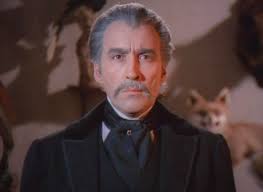
Universal Studios who was ready to go to court over Hammer’s “The Curse of Frankenstein” had gotten the message a year later and released “The Horror of Dracula” in the United States. Columbia Pictures released “The Revenge of Frankenstein” as the first of a five year exclusive deal with Hammer Films.
Below Christopher Lee in Hammer's "Dracula"
Below Christopher Lee in Jesus Franco's "Conde Dracula"
Universal Studios who was ready to go to court over Hammer’s “The Curse of Frankenstein” had gotten the message a year later and released “The Horror of Dracula” in the United States. Columbia Pictures released “The Revenge of Frankenstein” as the first of a five year exclusive deal with Hammer Films.
Let’s talk about that great scene were Dracula is destroyed in the Hammer production. In it Dracula seems to peel away his decaying skin which required Christopher Lee to have a layer of red make-up on his face. Next he was covered with a thin coating of mortician’s wax made up to look like his normal skin color. When he raked his fingers across the wax it revealed the “raw” marks underneath, but you never saw that?
The sequence was cut out of the film, but restored for the 2012 British Blue-ray release from some of the found footage of the legendary Japanese version of Hammer’s “Dracula”. For many years there has been talk about a longer and more explicit version of the film never seen outside of Japan and a few European countries. The last 36 minutes of that version has been discovered and is being added to a partly restored version that was to be released on March 18, 2013.

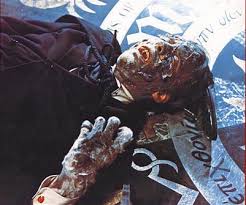
There are 19 more pictures directed by Terence Fisher starting in 1959 and I am not obviously going to look at each one, but pick a few of my favorites. I've discussed “Frankenstein” and “Dracula” so to finish the classic remakes of the Universal Studios own classic horror films. My next two are 1959’s “The Mummy” and 1960’s “The Curse of the Werewolf”.
The original plan producers Michael Carreras and Athony Nelson Keys had was to have Jimmy Sangster redo the classic 1932 Boris Karloff film “The Mummy”. In which he played Im-ho-tep and not the inferior films featuring first "B" Cowboy actor Tom Tyler and then Lon Chaney, Jr. as Kharis who remains in his mummy wrappings through four films. Carreras and Keys wanted Christopher Lee playing Im-ho-tep without the wrappings as Karloff had done. In fact Terence Fisher and Sangster were re-watching the film multiple times to kick around ideas on how to covert the Universal Studios classic directed by Karl Freund into a Hammer classic.
The problem came not from Universal International, but 71 year old Nina Wilcox Putnam the writer of the screenplay who had the rights to it not the studio. She outright hated the Hammer versions of Frankenstein and Dracula saying the studio was using color only to show blood and gore and the films was filled with half naked women. She outright refused Hammer Studio’s to touch her script. To be honest after she was dead there was no problem for Stephen Sommers and Universal to use her script for the 1999 “The Mummy” starring Brendan Fraser and Arnold Voslo as Im-ho-tep, but Hammer was stopped dead in their tracks.
Hammer then utilized three of the four later Mummy entries for his basic plot ideas starting with 1940’s “The Mummy’s Hand” with Tom Tyler creating the role of Kharis. Followed with two of the films featuring Lon Chaney, Jr. as Kharis. They were 1942’s “The Mummy’s Tomb” and 1944’s “The Mummy’s Ghost” with the climax of the Hammer film almost scene for scene copied from the climax of that last Universal film. 1944's "The Mummy's Curse" was left alone.

Tom Tyler as Kharis
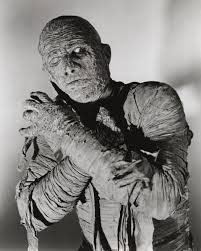
Lon Chaney, Jr. as Kharis

Christopher Lee as Kharis
In the Hammer film Peter Cushing plays “John Banning” the exact name of John Hubbard’s character in 1942’s “The Mummy’s Tomb” and Felix Aylmer plays Stephen Banning the name of Dick Foran’s character from that film and the original 1940 “The Mummy’s Hand”. From the 1944 “The Mummy’s Ghost” Sangster borrowed model/actresses Ramsay Ames, this was her only motion picture, character of the Princess Ananka, but the difference here was in the original film the name of the character who doesn't know she is the reincarnated Ananka was Aminia Mansori a kind of gypsy girl from the Louisiana bayous. While in the Hammer production she is Isabel Banning the wife of John Banning played by actress Yvonne Furneaux who was in the Errol Flynn film “The Warriors”, Federico Fellini's “La Dolce Vita” and Roman Polanski’s “Repulsion”. Of course Christopher Lee was now Kharis.

Ramsay Ames with Lon Chaney, Jr
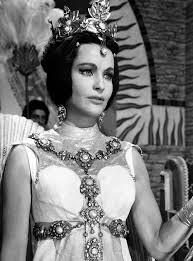
Yvonne Furneaux in "The Mummy"
Tom Tyler as Kharis
Lon Chaney, Jr. as Kharis
Christopher Lee as Kharis
In the Hammer film Peter Cushing plays “John Banning” the exact name of John Hubbard’s character in 1942’s “The Mummy’s Tomb” and Felix Aylmer plays Stephen Banning the name of Dick Foran’s character from that film and the original 1940 “The Mummy’s Hand”. From the 1944 “The Mummy’s Ghost” Sangster borrowed model/actresses Ramsay Ames, this was her only motion picture, character of the Princess Ananka, but the difference here was in the original film the name of the character who doesn't know she is the reincarnated Ananka was Aminia Mansori a kind of gypsy girl from the Louisiana bayous. While in the Hammer production she is Isabel Banning the wife of John Banning played by actress Yvonne Furneaux who was in the Errol Flynn film “The Warriors”, Federico Fellini's “La Dolce Vita” and Roman Polanski’s “Repulsion”. Of course Christopher Lee was now Kharis.
Ramsay Ames with Lon Chaney, Jr
Yvonne Furneaux in "The Mummy"
The movie was a critical success on both sides of the pond and strangely for a Hammer film as Nina Wilcox Putnam should have liked. No blood, gore, or half naked women. Actually the film owes its tone and style to those three Universal Studios original 1940’s Mummy productions and was truly a throwback to that era. Strange for Hammer.
There is a lie in the credits to my all-time favorite horror entry from the House of Hammer 1961’s “The Curse of the Werewolf”. The credits list Co-Producer Anthony Hinds using the pen name of John Elder as the writer of the screenplay. The actual writer was Guy Endore, but he was on the Hollywood Blacklist. Endore was upset, to say the very least, over the screen writing credits and in many interviews mentioned that Hinds did this almost for every screen writer on a film he produced.I was able to verify three other such incidents on the part of Anthony Hinds.

Before I go further let me introduce you to a 1933 novel that I read in Junior High School entitled “The Werewolf of Paris” by the same Guy Endore. The novel is considered to be the equal for werewolves as Bram Stoker’s “Dracula” is for vampires. The novel was re–released and is also available as an E-Book.
Before I go further let me introduce you to a 1933 novel that I read in Junior High School entitled “The Werewolf of Paris” by the same Guy Endore. The novel is considered to be the equal for werewolves as Bram Stoker’s “Dracula” is for vampires. The novel was re–released and is also available as an E-Book.
However, writing novels was not all that Samuel Guy Endore actually Samuel Goldstein did. His filmography includes the screenplays for both Tod Browning’s 1935 “Mark of the Vampire” and 1936 “The Devil Doll”. Along with 1935’s “Mad Love” starring Peter Lorre and Colin Clive whose poster has the tag line “Suitable Only for Adults” on it. Additionally he co-authored “The Story of G.I. Joe” which was really about War Correspondent Ernie Pyle and introduced Oscar nominated actor Robert Mitchum. Endore had also written a 19 page treatment for Universal Studios, that he received no credit for, that became the classic 1935 film “The Raven” starring Boris Karloff and Bela Lugosi.
Endore had a love for French history so besides “The Werewolf of Paris” he would write a novel “The King of Paris” based upon the life of Alexandre Dumas and two actual biographies. One was about Voltaire entitled “Voltaire! Voltaire!” and one about the infamous Marquis de Sade entitled “Satan’s Saint” among his other works.
As I mentioned Producer Anthony Hinds took all the screenplay credit for "The Curse of the Werewolf" based upon Endore's novel. The story’s location was moved from France to Spain and the film starred Oliver Reed in his first credited performance as Leon Coreldo.
The film as with the book tells the story of how a mute peasant girl is raped by a man turned crazy from being imprisoned as a jest of a nobleman. She escapes and is found by gentleman-scholar Don Alfredo Corledo and his housekeeper Teresa. The girl gives birth to Leon, but dies at the same moment. As the baby boy was born on Christmas Day by an unwed mother Teresa is worried about the legend that is now cursed. Don Alfredo does not accept the superstition and adopts the boy as his own.

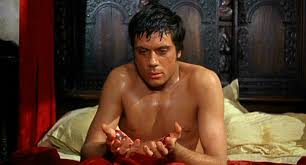

We next see the young boy Leon first effected by “The Curse of the Werewolf” when he kills a neighbor’s sheep. The neighbor aware of the signs considers his sheep killed by a werewolf and makes a silver bullet out of a crucifix should he meet it again.
As an adult Leon goes to work at a local winery and falls in love with the owner’s daughter Cristina. Leon's co-worker talks him into visiting a local brothel after he realizes his station will not permit him to marry the owner’s daughter. The adult Leon changes into a werewolf and kills a prostitute. Captured and in jail he tries to explain what is happening to him to the authorities who will not listen. Leon has also realized that Cristina’s love prevents the curse from taking effect and he could live a normal life with her.
However, Leon becomes the werewolf once more and in a sad twist of fate it his adopted father Don Alfredo who gets the silver bullet from his neighbor and ends Leon’s torment.
Oliver Reed’s make-up is very good for the first Technicolor werewolf. My only complaint is I would have liked to have seen more of the werewolf, but unlike Guy Endore’s novel where he has the liberty of covering many years and instances the movie only runs 91 minutes.
When Terrence Fisher directed Sir Arthur Conan Doyle’s classic “The Hound of the Baskervilles” in 1959. The screenplay by Peter Bryan turned the piece into pure Gothic Horror and even 55 years later the motion picture is considered one of the better versions. Once more the featured duo of Peter Cushing and Christopher Lee are seen, but not as the suspected Holmes and Watson.
Cushing plays Holmes in the film and would repeat the role in 1968. His performance was part of an excellent two part production on the BBC which is more faithful to the original Conan Doyle work than the Hammer film. Christopher Lee play’s Sir Henry Baskerville and retains third billing as the excellent Andre Morell was Dr. Watson.


The film is well remembered for its prologue telling with voice over by Francis de Wolff as Doctor Richard Mortimer the back story of Sir Hugo Baskerville and the legendary “HOUND OF HELL”. This whole section of Bryan’s script is pure Gothic Horror and directed by Fisher is one of the most effective sequences in any of his films. As it ends we cut directly to Dr. Mortimer in the sitting room of 221-B Baker Street speaking to Holmes and Watson. This is classic and unforgettable film making in my opinion.
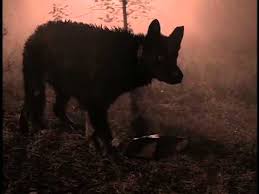
The film is well remembered for its prologue telling with voice over by Francis de Wolff as Doctor Richard Mortimer the back story of Sir Hugo Baskerville and the legendary “HOUND OF HELL”. This whole section of Bryan’s script is pure Gothic Horror and directed by Fisher is one of the most effective sequences in any of his films. As it ends we cut directly to Dr. Mortimer in the sitting room of 221-B Baker Street speaking to Holmes and Watson. This is classic and unforgettable film making in my opinion.
The problem with this version as is in every rendering of Conan Doyle’s novel is it is obvious to even the laymen that the character of Stapleton is behind everything. The only question not obvious to those unfamiliar with the story is the motivation behind him. A problem the filmmakers have with that character is finding a different way as to how Holmes is able to tie Stapleton to Sir Henry Baskerville. Each movie version tries to somehow change this physical trait as if that will make the audience not know the truth about the relationship between Sir Henry and Jack Stapleton.
I have seen many other filmed versions of the story with slight variations starting with Basil Rathbone and Stewart Granger. At a meeting of the Los Angeles Chapter of the “Baker Street Irregulars” I watched the weird 1937 Arthur Wontner film made by Twickenham Film Studios entitled “Silver Blaze” aka: “Murder at the Baskervilles”. It’s not really the story at all, but supposedly takes place years later. This interesting mix takes characters from both stories and others. Such as Sir Henry Baskerville, but tosses in Professor Moritarty and Colonel Sebastian Moran for flavor. Of note though in the film is a great Australian born character actor from 1929 through 1962 playing Watson, Ian Fleming and not that Ian Fleming.

Ian Fleming as Dr. Watson speaking to Arthur Wonter as Sherlock Holmes
Ian Fleming as Dr. Watson speaking to Arthur Wonter as Sherlock Holmes
Speaking of changes in the Hammer version. Bryan’s script adds in ritual sacrifice, a tarantula and that whole mine shaft scenario including Holmes becoming trapped. In the book Stapleton’s sister is named Beryl in the movie her name is Cecile. In the book she lives, but keeping with the Gothic tone of the Hammer script she is pulled under in the “Great Grimpen Mire”. In the film there is an attempt on Sir Henry’s life, but not in the novel. At the conclusion of the novel Stapleton does not get mauled to death after being shot by Dr. Watson. He simply disappears and is presumed to have drowned in the Mire. Of course that ending to the villain would not have kept to the Gothic nature of the film.

It is the scripts PURE GOTHIC HORROR that makes this film so gripping and classic thanks also to Terence Fisher’s tight direction and Alfred Cox’s outstanding editing. Not forgetting the tension caused by James Bernard’s score.
Moving forward three years and crossing the English Channel we come to Germany and Christopher Lee’s portrayal of Sherlock Holmes in “Sherlock Holmes und das Halsband des Todes (Sherlock Holmes and the Deadly Necklace)”. This West German-French-Italian International co-production written by American Curt Siodmak “The Wolfman”, “Frankenstein Meets the Wolfman”, “Son of Dracula”, “The Magnetic Monster”. Starring British Actors Lee as Homes and Thorley Walters as Dr. Watson while being directed by Terence Fisher.


Keeping to the International tone of the film. You had Austrian born film actress Senta Berger “The Victors” “Major Dundee” and “Cast of a Giant Shadow” playing Ellen Blackburn, you had a Swiss actor of Russian descent who was born in China Ivan Desny playing Paul King and German Actor Hans Sohnker as Moritarty.
The story simply is about Holmes and Watson attempting to recover a stolen necklace that once belonged to Cleopatra stolen by Professor Moriarty.
The movie was shot in July and August of 1962 in Ireland, London and the CCC-Studios in Berlin. Christopher Lee donned a false nose to play the part and would repeat the role of Holmes on British television in 1991’s “Incident at Victoria Falls” and 1992’s “Sherlock Holmes and the Leading Lady”.
Language was interesting according to Christopher Lee the film was originally shot in English, but the English audio track was recorded post-production by different actors mostly from the United States. So we are not hearing the original cast members in the English language version.
The film’s release is also interesting. The German premiere was on November 30, 1962. The Italian version was released May 3, 1963 and the French version “Sherlock Holmes et le collier de la morf” on May 20, 1963. The film under the title of “Sherlock Holmes and the Deadly Necklace” was not released in the UK until 1968 and the film went directly to television in the United States.
From Wikipedia:
Fisher and Lee were not happy with the film. Fisher called it "a film well worth left alone" and Lee said of it, "I think it was a pity, this film, in more ways than one. We should never have made it in Germany with German actors, although we had a British art director and a British director. It was a hodge podge of stories put together by the German producers, who ruined it. My portrayal of Holmes is, I think, one of the best things I've ever done because I tried to play him really as he was written, as a very intolerant, argumentative, difficult man, and I looked extraordinarily like him with the make-up. Everyone who's seen it said I was as like Holmes as any actor they've ever seen both in appearance and interpretation.
I want to mention 3 more films directed by Terence Fisher two of which came out in 1960 before “The Curse of the Werewolf” and the third after that production in 1962.
In “The Two Faces of Dr. Jekyll” aka: “House of Fright” aka: “Jekyll’s Inferno”. There is a small fight scene in a bar with Mr. Hyde where the thug that attacks him was played by Oliver Reed in his last non-credited role.
Wikipedia summarized the plot of the film this way:
In contrast to other film versions, Jekyll was portrayed as a rather bland and faceless person, while Hyde was presented as suave and handsome. This reflects director Fisher's belief in what critics (such as biographer Wheeler Winston Dixon) called "the charm of evil". The film is also unusual in that it is one of the few where the Jekyll/Hyde character does not die in the story's conclusion.
Dr. Jekyll
Mr. Hyde
I have only seen the film once, but the variation on the Stevenson story stuck with me. You could say also that in 1963 Jerry Louis did a variation of not only the Robert Louis Stevenson’s classic, but this film as well in his “Nutty Professor”. Where his somewhat ugly dork of a professor turned into a handsome and obvious singing version of his ex-partner Dean Martin.
Not only does writer Wolf Mankowitz do a twist of Stevenson’s Dr. Jekyll and Mr. Hyde persona’s, but he rewrites the plot further than anyone else has ever done. Playing the Jekyll and Hyde was Paul Massie a Canadian actor that appeared in only 7 films between 1959 and 1962 including this one and did some BBC and CBC television work afterwards. He became a Theater Arts instructor at the University of Florida from 1970 through 1996.
Playing his cheating wife Kitty was actress Dawn Adams “Riders to the Stars” “The Thousand Eyes of Dr. Mabuse” and Hammer’s 1970 film “The Vampire Lovers” with Peter Cushing based upon Sheridan Le Fanu’s classic lesbian vampire story “Carmilla” that predated Bram Stoker’s “Dracula” by 26 years.
The story line has Kitty having an affair with Jekyll’s best friend Paul Allen played by Christopher Lee. As a result Jekyll wants to understand the working of the human mind and creates his transformation portion and becomes Edward Hyde. Hyde is his young and handsome other self actually looking like the real Paul Massie, but is also a murderous and lecherous beast. In another twist in the story by Mankowitz Hyde starts watching Kitty and decides he wants her. She refuses him and he rapes and then murders Jekyll’s wife. Hyde then places all the evidence on Dr. Jekyll and figures he is in the clear.
The end comes when Hyde is confronted by the police and Jekyll fights back. There is a battle of wills with Jekyll winning over Hyde, but at a further price. It took so much energy to come back that Dr. Jekyll has aged many years and is grey haired with wrinkled skin.
The film cost 146,417 British pounds to make and lost Hammer Studios over 30,000. The subject matter was too much for the public’s taste. I like it for it originality and saw it under the title of “House of Fright”. Of course I was only a 14 year old boy, because the movie wasn't released in the United States until May 1961 while it premiered in the UK on October 24, 1960.
Transylvania, land of dark forests, dread mountains and black unfathomable lakes. Still the home of magic and devilry as the nineteenth century draws to its close. Count Dracula, monarch of all vampires is dead. But his disciples live on to spread the cult and corrupt the world...
So opens Hammer’s sequel, or maybe not a sequel to their “Dracula” the “Brides of Dracula”. I have mentioned Nina Wilcox Putnam statement twice before about her concern over Hammer Studios use of Technicolor blood, gore and half naked women. Her statement probably would have been very appropriate for this entry.
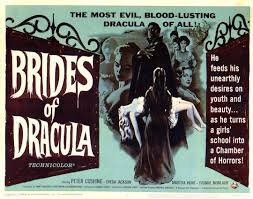
To begin with the script with this title was being written prior to Christopher Lee turned down appearing once more as Count Dracula. Jimmy Sangster immediately started to rewrite the script without Dracula although the name remained in the film's title for obvious reasons. Then Terence Fisher, Anthony Hinds and even Peter Cushing became involved with rewriting the script at one stage, or another. The final writing credits for the film read: Peter Bryan, Edward Percy, Jimmy Sangster on screen. However, as Guy Endore had experienced there was also the unaccredited Anthony Hinds credited and this time he actually was involved. Which may explain the end result.
According to Anthony Hinds:
According to Anthony Hinds:
My own personal involvement in a film like Brides was always 100 percent, not because I felt it to be my duty but because I felt very strongly that the pictures were mine. No doubt Terry [Fisher] thought they were his and Jimmy Sangster thought they belonged to him. And Peter C knew they were his.
The motion picture starred David Peel who up until this film was a minor role player in four films going back to March 1943. After the film shoot was completed Peel retired from acting to become an estate agent and antiques dealer. He played the mysterious chained up Baron Meinster a discipline of Count Dracula whose name is only mentioned two times in passing during the movie's 85 minute running time.
A young French schoolteacher named Marianne is about to take up a position when she is abandoned in a village by a coach driver. At an Inn she meets a nice elderly lady the Baroness Meinster who offers to put her up for the night. Against the warnings of the locals she accepts. Arriving at the castle she notices the Baroness’ handsome son chained up. He convinces her that his mother did this to keep the castle’s land for herself. The teacher makes the mistake of believing him and unleashes the vampire. Who promptly kills his own Mother!
Greta the servant of the family shows Marianne the bite marks on the Baroness’ neck from her son and the school teacher flees into the woods in fear. The next morning Professor Van Helsing JUST HAPPENS to be passing through the same woods and at the exact spot that Marianne being exhausted collapsed the previous night. Van Helsing escorts her to the school she is to teach at, but before this he asks her if she knows anything about the “undead”, or “vampirism”. Marianne says she doesn't know what he’s talking about EVEN AFTER having seen the Baroness the night before drained of all her blood through two tiny puncture holes in her neck.
The Baron will turn two young women into his “Brides” not Dracula’s and is after Marianne. At one point in a mill within a windmill, very important location, he goes after Van Helsing who has had his crucifix CONVENIENTLY fall into a well as Greta the servant and a non-vampire is killed in a fall. The Baron arrives and in a fight with Van Helsing is able to bite him on the neck. The Baron leaves thinking Van Helsing is now his, but Van Helsing regains consciousness and realizing what has happened to him. He takes a metal tool and heats it in a brazier and then places the hot metal against his neck. After which he pours holy water over the wound causing it to disappear and is now freed of turning into the thing he fights.
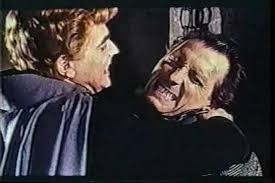
The Baron shows up at the mill with Marianne and there is a confrontation and another fight to save her. Van Helsing sees a canteen of holy water on the floor and is able to toss the water at the Baron’s face. The Baron screams as the holy water burns him like acid and in his agony overturns the brazier and starts a fire within the mill. Van Helsing takes Marianne up into the mill and moves the vanes of the windmill so that its shadow forms a cross stopping the baron and killing him.
There is no question that too many hands were on this script, but the movie somehow works. The original ending was to have had Baron Meister destroyed by a swarm of vampire bats released from hell by an arcane ritual used by Van Helsing. One of Peter Cushing’s contributions to the film was the vetoing of that ending. He felt Professor Van Helsing would never use black magic. Anthony Hinds liked that ending and would use it in the Don Sharp directed Hammer Film “Kiss of the Vampire” in 1963. Interesting note is that the script was written by John Elder the same writing pseudonym Anthony Hinds used for “The Curse of the Werewolf”. I think it is a safe guess that Hinds possibly was responsible for that same idea in “Brides of Dracula” until Cushing refused to do it.
My last film is Hammer’s version of French author Gaston Leroux’s story from 1909 “Le Fantome de l’Opera”. When one thinks of “The Phantom of the Opera” the first name that comes to mind is Lon Chaney in Carl Laemmle’s 1925 silent film directed by Rupert Julian for Universal Studios, and if you know your “Phantom” history when Universal wanted to re-shoot the piece in Technicolor. Lon Chaney. Jr. asked to recreate his father’s role and was flatly turned down and Claude Rains was given third billing behind opera singer/actor Nelson Eddy and newcomer opera singer Susanna Foster. Universal Studios was set to make a third version of the story in 1960 and just as they had brought back opera singer/actor Nelson Eddy, who had started making operatic musicals in 1936, to star in their 1943 version and play a part a good fifteen years younger than his then current age. They thought of 1940’s/1950’s movie musical star Kathryn Grayson to build the third version of the “Phantom” around, but that fell through and Hammer Studios picked up the option in exchange for the United States Distribution rights going to Universal.


Although it is a flawed film in many respects when I think of the “Phantom of the Opera” and acknowledging Lon Chaney for creating the role. I also think of Herbert Lom, Captain Nemo in Ray Harryhausen’s “The Mysterious Island” and the Chief of the Police Department who hates Peter Sellers in the “Pink Panther” films, over others who have played the role on the stage and in film. I am in agreement with Mike Sutton’s (Dvdtimes.com) view on Herbert Lom's Phantom.
Sutton wrote saying of Lom's peformance:
Sutton wrote saying of Lom's peformance:
as the sad, deformed Petrie is a triumph in every respect. Using exquisitely subtle body language and managing, somehow, to make the expressions in his single eye tell a whole story of pain and frustration, Lom is unforgettable. It may be heretical to say this but when I think of the Phantom of the Opera, it is Lom who comes immediately to mind.
Once more the script was by John Elder aka: Anthony Hinds, but there are a couple of interesting points before the film came into production. According to Hinds he wrote the romantic lead of Harry Hutter for actor Cary Grant who expressed an interest in being in a Hammer Film.
An interesting comment Herbert Lom made in an interview which brought up the film.
For one of my scenes, the Hammer people wanted me to smash my head against a stone pillar, because they said they couldn't afford one made of rubber,Lom continued.
I refused to beat my head against stone, of course. This caused a 'big crisis', because it took them half a day to make a rubber pillar that looked like stone. And of course, it cost a few pennies more. Horror indeed!
Marcus Hearn and Alan Barnes in “The Hammer Story: The Authorized History of Hammer Films” write that Terence Fisher’s direction was “misguided” and he just didn't have a feel for the story. A comment made about the film’s distributor "J. Arthur Rank Films" may explain the reason the film did terrible at the box office both in the UK and the United States. Apparently they felt Fisher’s cut was too long and according to Hearn and Barnes the “enasculation of the British print sealed its fate”. The cut also took away much of Lom’s Phantom’s dark, morbid side which made him a tragic hero. This comment reminds me of the editing that Universal did to the 1943 film that removed the one scene that confirms for the audience that he was Christine’s father.
One last interesting point about the American television releases of Hammer’s “Phantom of the Opera”, “The Kiss of the Vampire” and “The Evil of Frankenstein”. All three films had additional footage shot and added in the states before release to TV, because it was felt they were too short to run. One has to laugh a little at this after Rank's opinion of "The Phantom of the Opera".
PART THREE: MICHAEL RIPPER THE FACE YOU KNEW, BUT THE NAME YOU DIDN'T


No comments:
Post a Comment